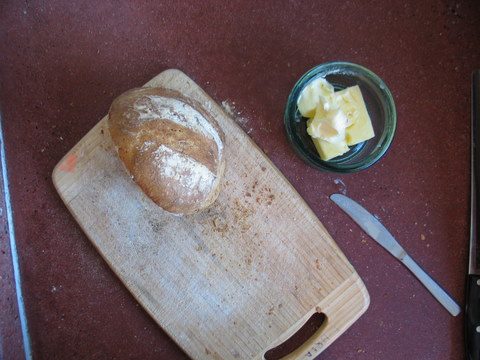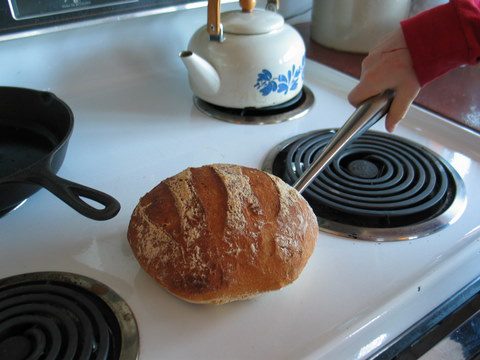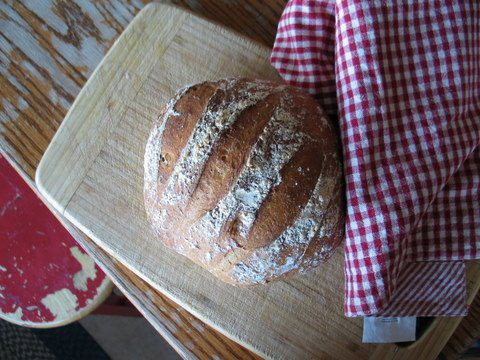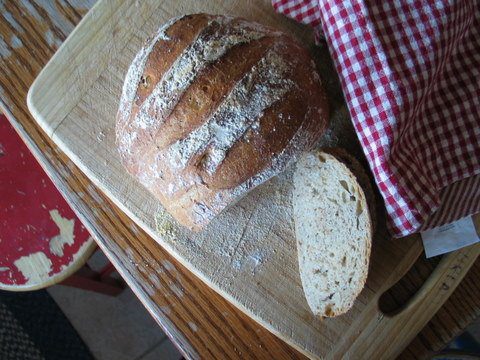Back to that bread, the five-minute, no-knead, there-is-no-way-it-can-be-any-good bread.
It is good and I recommend it, but, blast it all, it confounds me! It has made me feel unstable, like my world has been turned upside down and all the truths I hold dear are no longer worth two cents. But here it stands, a delicious bread, happily disregarding the most sacred of bread-baking truths. It is a bread so simple it makes me feel stupid.

That said, this bread, though quite excellent, is not the be-all and end-all. I will continue to make the standard knead-and-rise yeast breads. I will still make my sourdough breads, probably within the next couple days.
Because despite the fact that this bread is called an artisan bread, it doesn’t strike me as being totally authentic, and even though the flavor is pleasing, it doesn’t have the depth of integrity that I associate with sourdoughs. Although every loaf of sourdough doesn’t necessarily have an overpowering sour flavor, they do have a strength about them, a presence, if you will. Kind of like a wrinkly old lady who makes a kick-butt chow-chow, dons a floppy sunhat and a pair of men’s oversized rubber boots when she works in her gardens, and decorates her kitchen with a simple bouquet of wild flowers stuffed haphazardly into a mason jar. Reassuring, uncompromising, able-bodied, and earthy—that’s sourdough.
The five-minute bread is like a Birkenstock-wearing, soy-milk-drinking, Peace Corps volunteer living in West Africa, just a few anemic cacti lining the edge of the dirt yard.
Um, whatever.

Bread personifications and personal bewilderment aside, this is the ideal bread for anyone who breaks out in a sweat and starts biting their nails when they hear mentioned the word “yeast”. It’s a good bread for kids to learn with. It’s a good bread with which to wow your guests. It’s a good bread with which to wow yourself.
So now, go forth into the world, ye Bread Bakers, mix up some dough, with a spoon, yea verily, and do not knead it. Yay.

Five-Minute Bread
Adapted from the article in MotherEarthNews.com, emailed to me by my girlfriend Laurel.
For the first few batches of dough, I recommend using all white flour and then gradually adding the whole wheat so you have a bottom line from which to deviate.
I have not detected a sourdough flavor, though I have yet to keep the dough in the fridge for the full two weeks.
It takes a long time to bake, as in 40-60 minutes. Don’t be afraid to get the crust a nice dark brown color—the inside doesn’t seem to dry out at all. And the bread is best when it’s had a chance to cool for at least thirty minutes; otherwise, it is so moist it’s almost doughy.
A lump of dough makes a spectacular pizza crust. (Update, March 17, 2009: This is now my favorite pizza dough. One batch of this dough makes three large pizza crusts. I like to make two large pizzas for supper and save the leftover dough in the fridge for when I want to make a fast breakfast pizza, or a simple focaccia for an afternoon snack or a lazy Sunday supper.)
3 cups warm water
1 ½ tablespoons yeast
1 tablespoon salt
6 ½ cups white bread flour
Stir together the yeast and water and let rest for about ten minutes. Add the salt and flour and stir until incorporated. Cover the bowl with a towel and let the dough rise till about double. At this point you may bake if you wish, or you may put a shower cap over the container and set it in the fridge, for up to two weeks, cutting off hunks of dough when needed.
(Do not wash your bread bowl when you mix up the next batch of dough; simply stir the leftover bits and pieces of the dough into the new batch—that’s supposed to help it to get a deeper flavor more quickly.)
When you are ready to bake: Cut off a hunk of dough, whatever size you wish, roughly lump it into a ball and set it on a bread board, or cutting board, that has been heavily sprinkled with cornmeal. Sprinkle flour over the loaf, slash it a couple times, and allow it to rest uncovered for 30-45 minutes. (It may be better to slash it immediately before baking, after the rest period, but I’m still testing that one out.)
Place your baking stone on the bottom rack of your oven, and preheat the oven to 425 degrees. When the oven is hot, spritz it heavily with water, slide the loaf from the board onto the hot stone, spritz the oven again, and shut the door. Spritz the oven two more times in the next five minutes, and then keep the oven shut for the next fifteen minutes at which point you can check the loaf and rotate it as needed. Continue baking the loaf for about a total of 45-60 minutes, or until it is dark brown all over.






 And then The Baby Nickel climbed into the laundry basket,
And then The Baby Nickel climbed into the laundry basket,











